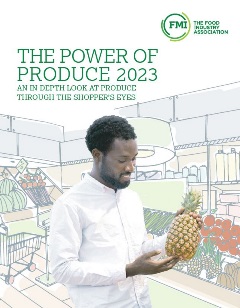“Power of Produce 2023” Offers In-Depth Look at Produce Buying Habits
ARLINGTON, VA — FMI – The Food Industry Association today released the Power of Produce 2023 report at the  Southeast Produce Council’s annual Southern Exposure event, revealing produce department sales grew 4.8% to $74.5 billion in 2022 even as inflation increased the price of fruits and vegetables.
Southeast Produce Council’s annual Southern Exposure event, revealing produce department sales grew 4.8% to $74.5 billion in 2022 even as inflation increased the price of fruits and vegetables.
More consumers are turning to valued-added produce – pre-cut and washed – and packaged salads, which provide convenience, but typically come with a higher price point per pound. Most shoppers (68%) say they’d like their store to carry a bigger selection of these time-saving produce products, despite higher prices and inflation.
“Consumers are continuing to purchase produce at roughly the same volume as in 2021 despite rising prices due to inflation. The shift we’re noticing is that shoppers turned to more affordable conventional fresh fruits and vegetables and canned and frozen vegetables rather than buying pricier organic items,’’ said Rick Stein, vice president for fresh foods at FMI. “Shoppers are searching for deals, but also willing to pay more for convenience – like pre-cut and washed products. This shows how complicated the consumer decision process is. On one hand, shoppers are saying price is important, but when it comes to convenience, they are willing to pay.”
Power of Produce 2023 is FMI’s eighth in-depth look at produce consumption and buying habits through shoppers’ eyes. Key findings include:
Fresh produce sales increase as volume drops
Sales of fresh fruits and vegetables reached $75 billion as prices climbed due to inflation, but pounds sold declined as 84% of consumers implemented money-saving measures, including looking for sales specials, buying less and shifting between types and stores. Some shoppers bought more frozen and canned produce rather than fresh.
While the volume of produce purchased in 2022 decreased from 2021, overall produce sales also remained ahead (19%) of 2019 numbers as did volume sales (3.4%), highlighting the continuing trend of consumers choosing fresh and healthy options despite higher prices.
Frequency of produce consumption
One-third of Americans typically consume fresh produce daily, while a majority (58%) say they eat fresh produce at least four to five days a week. Most shoppers (72%) always or usually include fresh vegetables with their dinner. Fresh fruit is consumed the most at breakfast (56%) and in snacking (38% evening, 44% afternoon or morning).
Price, appearance, convenience influence consumer store choice
Produce is the second-largest grocery store perimeter department behind meat. Almost one-third of shoppers (30%) say the produce department is a determining factor in where they shop for groceries. More than a quarter of shoppers (26%) rank price as the top factor when selecting and purchasing fresh produce.
Supermarkets are the most commonly shopped channel for fresh produce (72%) but nonfood formats, ranging from convenience to drug stores, are taking a bite out of traditional channels’ produce dollar. Just under half of households buy at least some fresh produce online, unchanged from 2022.
Organic produce takes a hit
After several years of aggressive growth for organic, the trend reversed last year, as organic produce volume decreased in 2022. One quarter of shoppers indicated they are purchasing cheaper fresh produce in light of inflation, which may further pressure organic sales in 2023, although many core organic consumers expect they will further increase their purchases.
Nutritional content important to shoppers
More than one-third of shoppers want more information on recommended daily totals and what constitutes a serving size when it comes to produce, while close to half of consumers want more information about the nutrition content, health benefits and ways to integrate produce into snacking. Current portion and nutrition knowledge is higher among those who frequently consume fresh produce — underscoring the importance of helping consumers make educated shopping decisions at the grocery store.
ABOUT THE REPORT
The Power of Produce 2023 was conducted by FMI and made possible by Yerecic Label, Southeast Produce Council, and Invafresh.
For Media:
- Members of the media may contact FMI for a gratis copy of Power of Produce 2023.
 Industry Topics address your specific area of expertise with resources, reports, events and more.
Industry Topics address your specific area of expertise with resources, reports, events and more.
 Our Research covers consumer behavior and retail operation benchmarks so you can make informed business decisions.
Our Research covers consumer behavior and retail operation benchmarks so you can make informed business decisions.
 Events and Education including online and in-person help you advance your food retail career.
Events and Education including online and in-person help you advance your food retail career.
 Food Safety training, resources and guidance that help you create a company food safety culture.
Food Safety training, resources and guidance that help you create a company food safety culture.
 Government Affairs work — federal and state — on the latest food industry policy, regulatory and legislative issues.
Government Affairs work — federal and state — on the latest food industry policy, regulatory and legislative issues.
 Get Involved. From industry awards to newsletters and committees, these resources help you take advantage of your membership.
Get Involved. From industry awards to newsletters and committees, these resources help you take advantage of your membership.
 Best practices, guidance documents, infographics, signage and more for the food industry on the COVID-19 pandemic.
Best practices, guidance documents, infographics, signage and more for the food industry on the COVID-19 pandemic.
